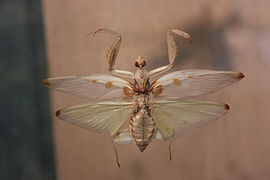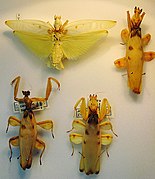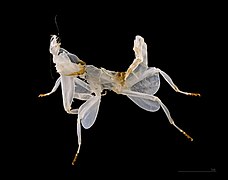| Hymenopus coronatus | |
|---|---|
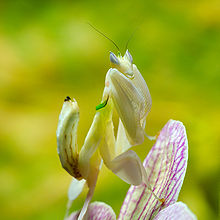
| |
| Sub-adult female | |
| Scientific classification | |
| Domain: | Eukaryota |
| Kingdom: | Animalia |
| Phylum: | Arthropoda |
| Class: | Insecta |
| Order: | Mantodea |
| Family: | Hymenopodidae |
| Genus: | Hymenopus |
| Species: | H. coronatus
|
| Binomial name | |
| Hymenopus coronatus Olivier, 1792
| |
Hymenopus coronatus is a mantis from the tropical forests of Southeast Asia. It is known by various common names, including walking flower mantis, orchid-blossom mantis and (pink) orchid mantis. It is one of several species known as flower mantis, a reference to their unique physical form and behaviour, which often involves moving with a “swaying” motion, as if being “blown” in the breeze. Several species have evolved to mimic orchid flowers as a hunting and camouflaging strategy, “hiding” themselves in plain view and preying upon pollinating insects that visit the blooms. They are known to grab their prey with blinding speed.
Description
[edit]This species mimics parts of the orchid flower. The four walking legs resemble flower petals,[1] and the toothed front pair is used as in other mantises for grasping prey.
H. coronatus shows some of the most pronounced size sexual dimorphism of any species of mantis; males can be less than half the size of females.[2] The female predatory selection is the likely driving force behind the development of the extreme sexual size dimorphism. Prior to development of its camouflage, the female mantis implements ambush predation to allow it to hunt larger pollinating insects.[3] An example of this ambush predation is the orchid mantis's ability to ambush foraging butterflies, a fairly large prey, which it captures using its pair of toothed arms and powerful bite.[4] As the female mantis continues to develop, much of its dramatic increase in size can be attributed to predatory selection and ambush predation.
First-stage nymphs mimic bugs of the family Reduviidae, which have a powerful bite and are foul-tasting.[5]
The mantis can change its colour between pink and brown, according to the colour of the background.[6]
Distribution
[edit]H. coronatus is found in the rain forests of Southeast Asia, including Cambodia, Indonesia, Laos, Malaysia, Myanmar, Thailand, Vietnam and the Philippines, as well as Singapore. It is also found in the Western Ghats of India.
Behaviour
[edit]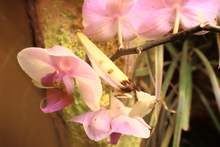
Hugh Cott referenced an early-20th-century account by Nelson Annandale of Hymenopus coronatus, in which he details how the mantis hunts on the flowers of the "Straits rhododendron" (Melastoma polyanthum). The nymph has, what Cott calls, "special alluring coloration", where the animal itself acts as a "decoy". The insect is pink-and-white (like many orchid blooms), possessing flattened limbs which feature "that semi-opalescent, semi-crystalline appearance that is caused in flower-petals by a purely structural arrangement of liquid globules or empty cells". The mantis climbs up-and-down the twigs of the plant until it finds a cluster of flowers. It holds-on to these with the claws of its two rearmost pairs of legs. It then sways from side-to-side, mimicking the wind; soon, various small flies and insects will land on and around the flowers, attracted by nectar as well as the small, black spot on the end of the mantis's abdomen, which resembles a fly. When a larger Dipteran fly—as big as a house fly—was observed landing nearby, the mantis at once seized and ate it.[7][8]
Mimicry has been widely discussed since the 1861 description by Henry Walter Bates.[9] While the orchid mantis is successful at catching its prey through its color mimicry alone, recent research shows that orchid mantises attract an greater number of natural pollinators when compared to actual flowers,[9] labelling these mantises as 'aggressive mimics'[9] with their ability to turn pollinators into prey. In a concurrent study, the spectral reflection of orchid mantises was measured using a spectrometer to determine how their colour may be perceived by other animals. Adult and juvenile orchid mantises primarily reflected UV-absorbing white and, based on visual modeling, their colour is indistinguishable from actual flowers (from the perspectives of the pollinating insects).[10]
The female of the species is, reported by Costa (quoting Shelford's 1903 account), to show parental care by guarding her eggs. Costa asks rhetorically "Why has so little [research] been done on parental care in mantids, such an unexpected and intriguing aspect of their behavior?"[11][12]
The camouflage of the orchid mantis probably deceives potential predators, as well as serving as aggressive mimicry of the orchid to help catch insect prey.[13][14]
Diet
[edit]The orchid mantis is a carnivorous insectivore, mainly catching other insects. In the laboratory setting, it prefers lepidopteran prey.[15] Its diet in nature is much the same as orchid mantises kept in captivity, and consists of small insects like crickets, flies, fruit flies, beetles, and smaller stinging insects such as bees or miniature wasps. They may also prey upon caterpillars and other insect larvae. Some are cannibalistic, eating their own kind when one strays too close.[16]
In human culture
[edit]History
[edit]
Alfred Russel Wallace in his 1889 book Darwinism, calls the mantis rare:
A beautiful drawing of this rare insect, Hymenopus bicornis (in the nymph or active pupa state), was kindly sent me by Mr. Wood-Mason, Curator of the Indian Museum at Calcutta. A species, very similar to it, inhabits Java, where it is said to resemble a pink orchid. Other Mantidae, of the genus Gongylus, have the anterior part of the thorax dilated and coloured either white, pink, or purple; and they so closely resemble flowers that, according to Mr. Wood-Mason, one of them, having a bright violet-blue prothoracic shield, was found in Pegu by a botanist, and was for a moment mistaken by him for a flower. See Proc. Ent. Soc. Lond., 1878, p. liii.
— Alfred Russel Wallace[17]
The drawing was published in Edward Bagnall Poulton's book The Colours of Animals. Poulton calls it an "Indian Mantis" which "feeds upon other insects, which it attracts by its flower-like shape and pink colour. The apparent petals are the flattened legs of the insect."[18]
Breeding
[edit]The orchid mantis is favoured by insect breeders, but is extremely rare, so is also extremely expensive.[16]
Additional images
[edit]-
Mounted adult male
-
Mounted female
-
Display of adult females
-
Last instar exuviae
-
Late instar female
-
Late instar female on flowers from Chiang Mai Province, Thailand
-
Adult male
See also
[edit]References
[edit]- ^ Gullan, PJ; Cranston, PS (2010). The Insects: An Outline of Entomology. Wiley (4th edition). Page 370.
- ^ Prete, 1999. p.107.
- ^ Svenson, Gavin J.; Brannoch, Sydney K.; Rodrigues, Henrique M.; O’Hanlon, James C.; Wieland, Frank (December 2016). "Selection for predation, not female fecundity, explains sexual size dimorphism in the orchid mantises". Scientific Reports. 6 (1): 37753. Bibcode:2016NatSR...637753S. doi:10.1038/srep37753. ISSN 2045-2322. PMC 5131372. PMID 27905469.
- ^ Chen, Gao; Zhao, Guang‐Hui (February 2020). "Orchid mantis ambushes foraging butterflies". Frontiers in Ecology and the Environment. 18 (1): 12. doi:10.1002/fee.2155. ISSN 1540-9295.
- ^ Gurney (1951). "Praying Mantids". Annual Report of the Board of Regents of the Smithsonian Institution. 105. The Smithsonian Institution: 344–345.
- ^ Prete, 1999. pp. 283–184.
- ^ Cott, 1940. pp 392–393.
- ^ Annandale, Nelson (1900). "Notes on the Habits and natural Surroundings of Insects made during the 'Skeat Expedition' to the Malay Peninsula, 1899-1900". Proceedings of the Zoological Society of London: 837–868.
- ^ a b c O’Hanlon, James C.; Holwell, Gregory I.; Herberstein, Marie E. (2014-01-01). "Pollinator Deception in the Orchid Mantis". The American Naturalist. 183 (1): 126–132. doi:10.1086/673858. ISSN 0003-0147. PMID 24334741. S2CID 2228423.
- ^ O'hanlon, J. C.; Li, D.; Norma-Rashid, Y. (July 2013). "Coloration and Morphology of the Orchid Mantis Hymenopus coronatus (Mantodea: Hymenopodidae)". Journal of Orthoptera Research. 22 (1): 35–44. doi:10.1665/034.022.0106. ISSN 1082-6467. S2CID 13867074.
- ^ Costa, James T (2006). The Other Insect Societies. Harvard University Press. pp. 138–139.
- ^ Shelford, R (1903). "Bionomical notes on some Bornean mantids". Zoologist. 4: 298–304.
- ^ Boucher, Douglas H (1988). The Biology of Mutualism: Ecology and Evolution. Oxford University Press. p. 207.
- ^ "Research finds orchid mantis doesn't mimic an orchid after all". phys.org. Retrieved 5 April 2021.
- ^ Prete, 1999. p.313.
- ^ a b "Hymenopus Coronatus (Orchid mantis) Caresheet". InsectStore. 25 January 2006. Retrieved 5 January 2013.
- ^ Wallace, 1889. Note 80.
- ^ Poulton, 1890. pp 74–75.
Bibliography
[edit]- Cott, Hugh Bamford (1940). Adaptive Coloration in Animals. London: Methuen.
- Poulton, Edward Bagnall (1890). The Colours of Animals: Their Meaning and Use, Especially Considered in the Case of Insects. Kegan Paul, Trench, Trübner. pp. 74–75.
- Prete, Frederick R (1999). The Praying Mantids. JHU Press. p. 313.
- Wallace, Alfred Russel (1889). . Macmillan – via Wikisource.
- O’Hanlon, James C.; Holwell, Gregory I.; Herberstein, Marie E. (2014-01-01). "Pollinator Deception in the Orchid Mantis". The American Naturalist. 183 (1): 126–132. doi:10.1086/673858. ISSN 0003-0147.Svenson, Gavin J.; Brannoch,
- Research on how orchid mantises catch and attract their prey. Use information about orchid mantis behavior.
- Sydney K.; Rodrigues, Henrique M.; O’Hanlon, James C.; Wieland, Frank (2016-12-01). "Selection for predation, not female fecundity, explains sexual size dimorphism in the orchid mantises". Scientific Reports. 6 (1): 37753. doi:10.1038/srep37753. ISSN 2045-2322.
- Explains the differences in behavior, description, and reproduction in female orchid mantises versus males.
- O'hanlon, J. C.; Li, D.; Norma-Rashid, Y. (2013-07). "Coloration and Morphology of the Orchid Mantis Hymenopus coronatus (Mantodea: Hymenopodidae)". Journal of Orthoptera Research. 22 (1): 35–44
- Describes the color and morphology of orchid mantises, as well as their ability of mimicry.
- O’Hanlon, James C.; Holwell, Gregory I.; Herberstein, Marie E. (2014-01-01). "Pollinator Deception in the Orchid Mantis". The American Naturalist. 183 (1): 126–132. doi:10.1086/673858. ISSN 0003-0147.Svenson, Gavin J.; Brannoch,

